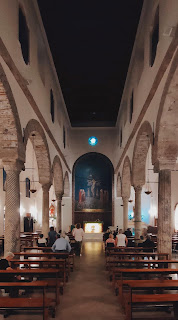GdS Experience - Salerno - Chiesa del Crocefisso
The Church of S. Maria della Pietà, its architectural lineage tracing back to the enigmatic epochs of the 10th and 11th centuries, once bore a different name. Until the year 1857, it was known by its former appellation, before it embraced the title of SS. Crocifisso. During that pivotal year, it played host to the parish of San Benedetto, albeit temporarily, as military forces shuttered its sacred doors.
Beyond the church's hallowed confines, along the lateral wall that gazes upon Via Mercanti, the observer is graced by the original Romanesque masonry, its facade adorned with monofore, like ancient eyes that once beheld the passage of centuries. The passage of time has etched its signature upon this sacred enclave throughout the 20th century. In 1928, a new facade emerged, an academic interpretation, crowned by an overhanging portico that mirrored the church's interior, with its three apses. Following the tumultuous floodwaters of 1954, the church was painstakingly restored and fortified, reviving its original visage in a false neoromanesque garb. The second facade, a more recent addition, embraced the interior of the 20th-century portico, while to its right, a bell tower was raised to pierce the heavens.
Beneath the feet of worshippers lies a hidden realm, the crypt, officially unveiled in the year 1950. It is believed to precede the upper church, its origins harkening back to the 8th century. A celebrated fresco of the Crucifixion, dating back to the 13th or 14th century, stands as a testament to the Angevin influences that once graced Salerno, within a fully functioning subterranean sanctuary.
The crypt, much like its celestial counterpart, boasts a basilican floorplan, its heart adorned with three naves, their division marked by vaulted cross arches, their ascent culminating in three apses facing the east. These arches cradle themselves upon pilasters, enshrining the ancient columns of yore. Along the northern wall, monofore bestow their timeless grace, a silent chorus to the crypt's enigmatic sanctity.





Comments
Post a Comment